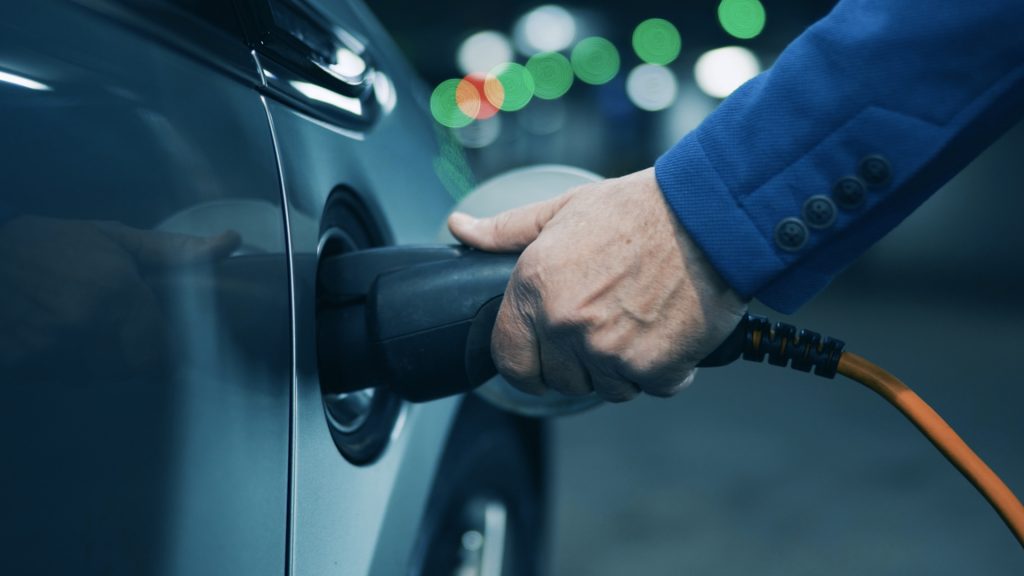Welcome back to the continuation of our podcast! This next series focuses on the business and design challenges facing today’s Transportation and Mobility (T&M) industry in relation to designing the cars of the future.

In this first T&M podcast episode, Brad Duncan & Jonathan Jilesen from SIMULIA’s T&M organization weigh in to share their thoughts on the latest trends and challenges facing the industry and how that is impacting the design of Electric, Connected and Autonomous vehicles.
The design process really needs to change to much more of a concurrent process. All the people that are the subject domain experts in all these different areas need to be able to collaborate and come up with an innovation that will solve a problem – Brad Duncan
Enjoy the podcast with Brad Duncan & Jonathan Jilesen.
3D Design and Engineering
Electric, Connected & Autonomous Vehicles
Be sure to listen into the other podcasts in this series and to learn more, please visit: https://go.3ds.com/TM
Subscribe and listen to the podcast series on the following channels:
Podcast Transcript

Matthew Hall 0:10 Hello and welcome to the Dassault Systèmes podcast, 3D Design and Engineering. From vehicle system architecture, battery thermal management, high speed electric motor lubrication to multi discipline collaboration, there are multiple changes impacting and disrupting the industry that is designing future vehicles that we will be driving or those that will be driving us.
In this series here on our podcast, we will be focusing on some of the latest trends challenges and solutions that are going on right now in the Transportation and Mobility industry, specifically that are impacting Electric, Connected and Autonomous Vehicles, also known as ECAV’s.
I’m your host Matthew Hall. In joining us today I have with me two colleagues of mine, Brad Duncan. He’s the Technical Director with the SIMULIA Transportation and Mobility Enablement Organization. And Jonathan Jilesen, Senior Manager within the SIMULIA Transportation and Mobility Aerodynamics Organization. Our guests bring a combined 45 years of experience to the industry, and unique insights that will provide for a very informed discussion today. Welcome, Brad and Jonathan.
Brad Duncan 1:19 Thank you, Matthew.
Jonathan Jilesen 1:19 Thank you, Matthew.
Matthew Hall 1:20 Thanks for joining us today. So let’s dive right in and get started. First, from your perspective, what do you see as the key disruptive trends that are happening now throughout the industry, as it relates to the current development, thoughts and process around ECAV’s?

Brad Duncan 1:38 Matthew I’ll start. So I work in a lot of work in aerodynamics, and we’ve seen a huge increase in interest in aerodynamics. Basically, aerodynamics drives the ability of the vehicle to reach its target range and tackle that number one problem that consumers have, which is “Range Anxiety.” So by integrating the vehicle design process with aerodynamic simulation, we can help provide a solution to designing a vehicle that will reach its range requirements. So I feel like that’s one of the front and center, you know, urgent needs of the industry to design electric vehicles. But it’s by far not the only one. There are many, many other aspects of the electric vehicle system that relate to the design and we do simulations of fluids and other systems in order to provide the right performance for the vehicle.

Jonathan Jilesen 2:30 The the other trend, I guess, that I see is that the focus is being more on the experience of the driver of the vehicle. So that means introducing autonomous features to the vehicle to alleviate the amount of attention that the driver has to give to driving to free them up to do other things like check their email, or having conversations on the phone, conducting meetings, even playing guitar – I’ve seen some ads like that. But with that it increases the complexity of the vehicle. It means that there’s more things to be considered both for aerodynamics, but also from the adverse conditions aspect. So yeah, so we have to be able to like so these new systems that we’re designing has to be able to cope with the real world where we have dust, dirt, salt spray, as well as wind gusts that are going to affect the way the system has to behave. And it has to be able to react in a positive way without endangering the occupants of the vehicle.
Matthew Hall 3:37 That would be ideal. Those are great insights on those dreams, those trends, that term the “range anxiety” I mean, I never even heard of that trend. But uh, it makes total sense. And, you know, from the driver experience, you know, it’s going to be a totally different experience for them if it’s in a ECAV.
So secondarily, from a high level, and with all these different disruptive changes that are happening in the nm, the transportation mobility industry today, what do you see from very high levels of biggest challenges when it comes to the industry rethinking its overall design experience?
Brad Duncan 4:12 Well, let me start with one main challenge is that the way that vehicles are designed, right? It starts with using knowledge that’s from legacy designs and say brand identity and what they think consumers want. But because all of those things have changed so much, it really requires a rethink of the design process itself. Instead, you need a aesthetic design, and a system design. And then it’s surrounded by all these kind of concurrent concerns about how to make the attributes of the vehicle, really perform well, and considering a completely new driver experience. So I think, you know, where I see that’s disruptive is that the design process really needs to change to much more of a concurrent process. All the people that are the subject domain experts in all these different areas need to be able to collaborate and come up with an innovation that will solve a problem that maybe it’s never been solved; that there may be a future design that would be much improved, in terms of its performance and the driver experience. And you can’t depend on legacy knowledge to solve that problem.
Jonathan Jilesen 5:17 Yeah, I guess along with that, you have a lot of built in, as Brad was calling legacy knowledge. But a lot of times it’s kind of rules of thumb of like: “Okay, well, if if I do this, if I have this kind of height of an a pillar step, or if I put the mirror in this certain location, then it’s going to react in a certain way.” And that’s traditionally been fairly true, because the vehicle shapes aren’t changing drastically. But what I’ve seen in as a trend in the industry is that the shapes are going to change drastically, once we go to autonomous vehicles, especially for those that are driving in-city. And that means that you’re going to have completely different aerodynamics behavior, completely different acoustics behavior. Also, again, with like how the dirt and water is going to interact with that, and how you’re going to build a manage that is all going to be different.
Brad Duncan 6:07 Right, one of the things Jonathan’s works on is the water management. So if you think about pouring water over the car, where will they go, and then you know, maybe it’s stationary, and then it starts moving, and then the water, you know, moves to different area, and then it starts raining, and then you get behind a truck, and it’s spraying water all over you. So that not only affects visibility now, but it affects all these sensors, and all the systems and they have to perform and be kind of immune to this contamination. And whereas today’s vehicles, it’s primarily a safety issue – do I see out of my rearview mirror? do I see out of the windshield with the wipers on? So it’s really a different way of thinking that that the OEM have to consider.
Jonathan Jilesen 6:46 The other aspect of that is, when you have a human driver, they can get out of the car. And under worst conditions, they’re gonna pull over to the side of the road, they get out of the car, they get out of cloth, they wipe it off, they clean it. We don’t necessarily have those systems in place on the vehicle. If it’s a ECAV vehicle, although for the most critical systems, we’re going to have to have that we’re going to have to have spraying systems to be able to clean it because you might be a disabled person in the vehicle, and relying on it completely to get them from point A to point B.Very true.
Matthew Hall 7:23 Okay, great. For our listeners of the podcast here, can you guys differentiate your team and the value that you bring to the SIMULIA family that can help the future of designing ECAV’s, especially in light of what we’ve discussed so far?
Brad Duncan 7:39 Certainly, yeah. And I think that’s where we have multiple podcasts where you can talk about different teams and different capabilities. Our team is really focused on the fluid systems that are important for the vehicle performance, aerodynamics, water, which is coming from rain and roads sprays; we focus on the cooling flows going into cooling areas to cool the engine, the battery, on different vehicles. So in this case, with the battery, there’s a system that’s kind of similar, and it has to, you know, blow air with a fan and cool a heat exchanger, and that has to cool the battery. And then there’s also flow around the battery that helps with cooling, of course, you need airflow into the cab, and then to be able to have all the human comfort. So, you know, basically the airflow is all around the vehicle. And that air flow on a real road is contaminated with all kinds of other things. So that’s what our team provides. And SIMULIA has a complete capability to simulate the environment that the vehicle is traveling through on the road. You don’t have to take the car to the wind tunnel, you know, or several wind tunnels is done today, to find out how it’s going to perform on the road; you can do it all in simulation.
Jonathan Jilesen 8:55 Yeah, and we were bringing all of our experience to bear on this, too because we’ve developed these best practices that are going to work on all these new shapes. And they also provide much more insight than we would typically get from the traditional experiments that we would do, such as wind tunnel testing, or Climactic Tunnel testing, where you basically either just getting a drag number out, you might be able to do some smoke traces. With the news solvers that we have, we can give them exactly where the air goes, we can trace it, we can do the salt spray on real world conditions, as Brad pointed out, without fear of damaging the vehicle or any of the equipment. And so we have a much more flexibility to be able to and much more certainty when we test in these conditions.
Brad Duncan 9:47 Jonathan, one of your key capabilities is if you have a sensor that’s getting contaminated, you can try to solve it solve that problem, in the minimum amount of time.
Jonathan Jilesen 9:55 Right. And we can we can iterate on many different designs in parallel.
Brad Duncan 9:59 And find the source and then find out why that sensor is getting contaminated. I think most of our customers will say that Climactic Tunnels are very difficult to get information about how to improve; you can see something’s getting contaminated, but what do you do about it?
Matthew Hall 10:14 All right, let me ask another question to you both. What are your suggested solutions to managing the complexity that exists in the various ECAVs’ subsystems today.
Jonathan Jilesen 10:24 So these systems are very complex. And you have to consider things like EMAG. So the electrical interference between the sensors and the data from the cameras, as well as…ECAV systems are very complex, much more complex than we’ve traditionally dealt with. That means that we need a lot more collaboration between our different teams. So whereas traditionally, things have been more siloed, we need to have a lot more discussion amongst groups, going from electromagnetics, to acoustics to aerodynamics, and thermal management, having everybody talking together. And having a numerical solution where we can do that early in the design is really beneficial because we can collaborate in that kind of digital space to quickly come to a mutually beneficial solution – or the optimum solution.
Brad Duncan 11:21 One of the areas where we have to collaborate is between the electromagnetic capability and the fact that you know, in the airflow, you have the water and the particles contaminating sensors. So understanding when is that can actually degrade the performance of the sensor, and how do you design say, a cleaning system, so it’s definitely multi disciplinary, multi-physics multi-scale; you’re looking at a problem on the scale of a tiny lens, and on the scale of the entire vehicle airflow at the same time.
Matthew Hall 11:50 Jonathan, you mentioned the complexity of this the collaboration needed across the enterprise, you see customers leveraging the cloud a lot to help them overcome the challenges of a globally dispersed teams and the complexities involved in designing these ECAV’s.
Jonathan Jilesen 12:06 And definitely, we have customers that most of our customers are global. And they do leverage that they break up systems globally. So it will have somebody in England working on brakes, for example, and you could have somebody in the US working on acoustics… and all those teams have to work together, even though there’s different timelines and stuff. And the cloud really benefits that. We’ve also had live design studies where we’ve used the cloud so that there’s this kind of space where we can both interact with the models at the same time. So I can point out some kind of design change that I would like to see and kind of rotate the model into a view and have the other person on the other side of the world, seeing that same view, and then commenting on what their opinion is on that change that I proposed. So the cloud really makes that possible.
Brad Duncan 13:00 We almost take it for granted. We use it all the time. But I mean, just think about how much that enables cross team collaboration, to actually look at something instead of having to say type it into a report or both attend the same wind tunnel test.
Matthew Hall 13:14 Incredible. The last question I have for you is what unique simulation challenges and solutions do we have for the developmental future of ECAV’s, beyond traditional crash testing and simulations?
Jonathan Jilesen 13:26 Currently, our solution for particle tracking is very unique in the industry, allowing the very tight coupling of transit and aerodynamics with the motion of the dirt and water in the air. I think that we’re going to continue to grow that capability, improving on the domains that it can tackle. I think that we’re going to continue to develop more multi-physics. So incorporating EMAG into our suites, and then making sure that we can have the interaction of those different elements being taken into account.
Brad Duncan 14:03 We have systems that are very sensitive to contamination, like brakes, and air intakes and batteries. So you know, if you look underneath the vehicle, there’s all kinds of areas where particles can detrimentally affect the performance. So being able to track where they were going, have them picked up by you know, very complex airflow; like one of the key interesting problems is the wheel that will spray up particles, and then they can contaminate the brakes, and then affect the brake performance. But if you know that you can actually affect the design and improve the aerodynamics and keep that wheel spray away from the brakes or protect them with the appropriate kind of brake cover. Yeah, so there’s all these different areas where being able to, to know where particles come from and where they’re going and actually visualize that is the key to finding a design solution.
Jonathan Jilesen 14:55 Yeah, also from the thermal aspect, because as we get these dirt, water into the electronic systems, they can cause havoc. If you’re relying on those systems, you really want to protect them as best you can. Also for thermal or heat rejection. So you want to make sure that you’re getting the expected cooling airflow, getting the heat out of the system that you weren’t expecting to.
Matthew Hall 15:19 This is a great conversation, guys. And I thank you both. It was very eye opening. So thank you, Brad and Jonathan, for sharing all your thoughts and insights today with us.
Jonathan Jilesen 15:27 Thank you, Matthew.
Brad Duncan 15:28 Thank you, Matthew, our pleasure to talk to you about this today.
Matthew Hall 15:30 Right. Thank you. And thanks to everyone, for listening today. I feel we all have a better idea as to the intricate challenges designers of the future’s, Electric, Connected and Autonomous Vehicles have on their hands. Find out more how Dassault Systèmes is helping advance the design process for Electric, Connected and Autonomous Vehicles in the Transportation and Mobility industry, please go to ifwe.3ds.com/transportation-mobility. And finally, don’t forget to subscribe to the podcast series and listen to all the other fascinating entries we have available on iTunes, SoundCloud, or whatever major podcast channel you listen to your podcast.
I’m Matthew Hall. Make it a great day!










